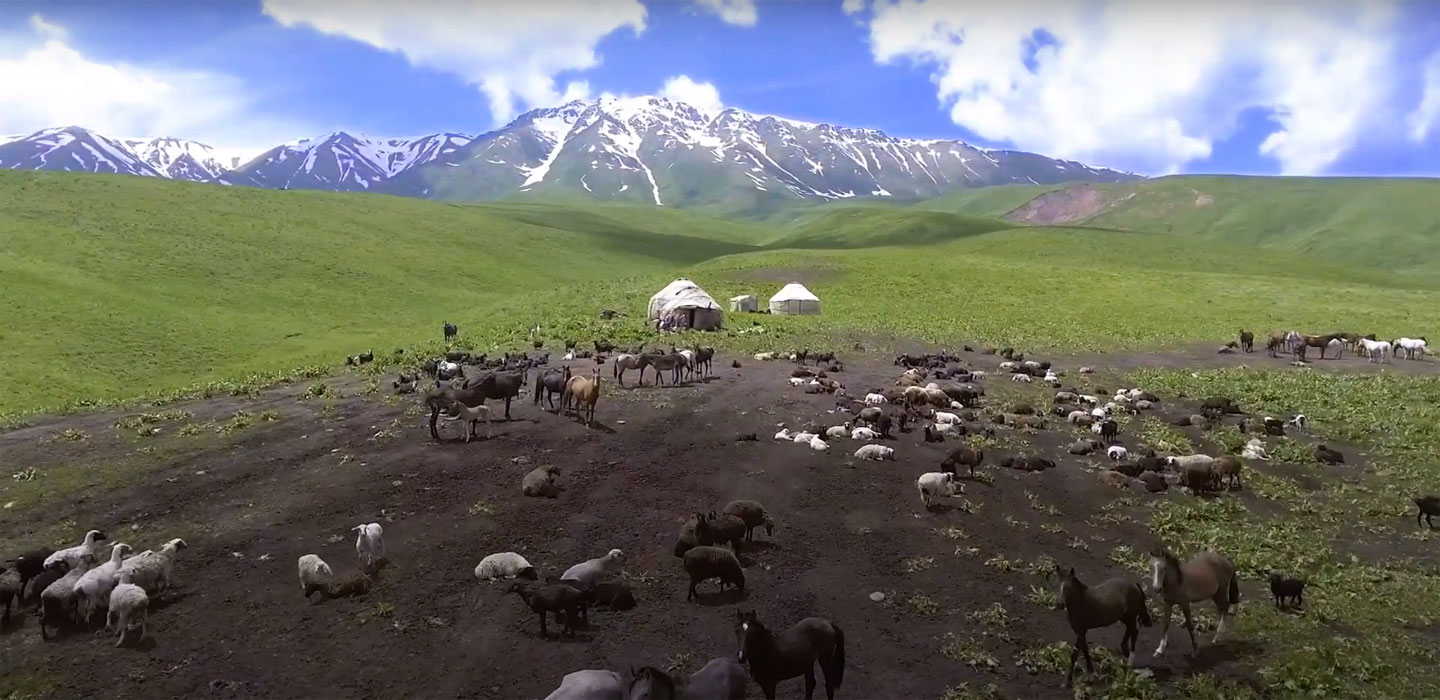In Kyrgyzstan, new technology preserves age-old pastures
IFAD Asset Request Portlet
Asset Publisher
In Kyrgyzstan, new technology preserves age-old pastures
Estimated reading time: 4 minutes
Urmatbek Omurbekov remembers a time when grazing his livestock was a purely offline affair. Every spring, herders like him would bring their animals to the foothills of the majestic Tian Shah Mountains to let them fatten up for the next winter.
In this part of the world, most families own livestock. It’s common to see goats and cattle running free alongside horses and yaks, and the locals let each other know when they run into a neighbour's sheep or cow lost in the mountains.
But against this idyllic backdrop, disputes have flourished in recent years. More often than not, they’re about the increasingly depleted grazing lands.
The generations of Kyrgyz herders before Urmatbek’s were nomads, migrating their livestock throughout the mountains and across the plains. Today, however, most livestock keepers are settled in the lowlands and no longer travel to feed their animals. As a result, the pasturelands close to their communities have become overused, while good grazing lands farther afield remain untouched. This uneven usage both harms the environment (by, for example, increasing erosion and other localized damage) and makes the animals less healthy and productive.
That's why IFAD has been working with the Government of Kyrgyzstan to fund programmes like the LMDP that empower communities to work in smarter ways with the available land resources. Part of this process has involved introducing remote sensing technology into Kyrgyzstan’s existing pasture management system and putting that digital technology straight into the hands of livestock keepers like Urmatbek.
“We learned with the help of the Google Earth programme to read electronic maps that help us create pasture management plans," he says.
Urmatbek is the head of the Cholpon Zhayit committee, one of almost 70 pasture committees in Naryn, Kyrgyzstan’s largest administrative region. It’s also the country’s poorest. For decades, these pasture committees, composed of local herders and livestock keepers, have been tasked with administering grazing rights. They use a ticketing system to determine who can graze where, with ticket prices set by the community and proceeds going towards communal expenses like repairing water troughs.
But although the structure for governing these grazing lands was already in place, pasture committees like Urmatbek’s have lacked the tools to determine which lands were underused or overused and which were at risk of becoming depleted. They also didn't have a good overview of how the quality of individual grazing plots changed depending on the season.
That all changed with the LMDP. The programme has provided the pasture unions with the technology and training needed to digitize maps of grazing areas and use online geographic information systems.
With the help of GPS devices purchased by the programme, the unions were able to determine the geographic coordinates of their pasture plots. This has allowed them to do everything from identifying areas in need of new infrastructure (such as bridges and roads) to designating certain areas for research purposes (e.g., for techniques to improve yields).
Meanwhile, the use of imaging from geographic information systems helped them establish a baseline for the state of the various pastures in their area. This makes it possible to compare the yields and the health of those grasslands from year to year and season to season, and to intervene when necessary to protect pastures against overgrazing. The committees can, for example, cordon off specific plots that need to recover and issue tickets only for healthy fields.
As a result, livestock keepers in Issyk-Kul, Naryn, and Osh, the regions in which the programme is active, have seen increases in milk yields and decreases in conflicts. A study undertaken at the completion of the programme’s first phase found that the body weight of an average livestock animal had increased by up to 50 per cent and the number of conflicts had gone down by more than 20 per cent.
Meanwhile, the reseeding of depleted plots is under way, thanks to a collaboration between the Association of Pasture Users’ Unions and the Kyrgyz Scientific Research Institute of Livestock Breeding and Pasture, with the support of IFAD.
What's more, the programme funded a new early warning system for extreme weather that can reach herders even in the most remote pastures and help them make better grazing choices.
“The system offers a convenient source of weather notification for the next 10 days," says Karybek Karabaev, head of the Zhoosh pasture committee in the Osh region. "For example, we have a site in a remote pasture in the Alai mountain range, and this year we’ve started to supply pasture users there with weather data."
From his phone or computer, Karybek now goes to a website that specializes in weather data for pastures and finds the pasturelands under his committee’s jurisdiction. He then distributes the information among the pastoralists by calling them directly on their mobile phone, which allows them to plan grazing paths a safe distance from extreme weather conditions.
The website Karybek uses and several other aspects of the early warning system are now managed by Kyrgyzstan’s Department of Pastures and Livestock.
On the surface, the picture today is still the same as a decade ago: cows and horses and sheep and yak roaming free on lush green hillsides and valley pastures. But now it runs on a sophisticated digital system – one that allows for pasture management plans and forward-looking decisions, so that both pastures and livestock will stay healthy and productive for decades to come.
Read more about IFAD's work in Kyrgyzstan
Publication date: 22 April 2021